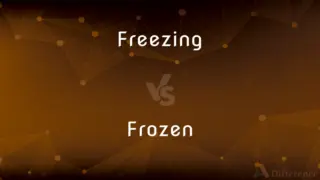Shiplap vs. Beadboard — What's the Difference?
By Tayyaba Rehman & Maham Liaqat — Updated on May 15, 2024
Shiplap features wide, horizontal boards with rabbeted edges for overlapping, creating a smooth surface, while beadboard consists of narrow, vertical planks with a distinctive beaded edge for a more textured look.

Difference Between Shiplap and Beadboard
Table of Contents
ADVERTISEMENT
Key Differences
Shiplap is characterized by its wide, horizontal wooden boards with rabbeted edges, which allow the boards to overlap and fit snugly together, creating a flat, smooth surface. This style is often associated with rustic or coastal decor, giving spaces a clean and linear appearance. Beadboard, on the other hand, consists of narrow, vertical planks with a distinctive beaded edge detail where each board meets. This design results in a textured and patterned surface, often used in traditional or cottage-style interiors.
In terms of installation, shiplap is typically easier to install because of its overlapping design, which can cover imperfections in the wall beneath. Beadboard installation can be more meticulous, as aligning the narrow planks requires precision to maintain the consistent beaded pattern.
Shiplap is often painted or stained to enhance its clean, seamless look, making it popular for modern farmhouse and contemporary designs. Beadboard, however, is frequently left in its natural wood state or painted in light colors to highlight its intricate details, fitting well in classic or country-style decors.
Functionally, shiplap's overlapping boards provide good insulation and protection from the elements, historically used in barns and sheds. Beadboard, although more decorative, can also add insulation and cover wall imperfections but is primarily used for its aesthetic appeal.
Comparison Chart
Board Orientation
Horizontal
Vertical
ADVERTISEMENT
Edge Design
Rabbeted edges for overlapping
Beaded edge detail
Surface Appearance
Smooth, flat
Textured, patterned
Style Association
Rustic, coastal, modern farmhouse
Traditional, cottage, country-style
Installation Ease
Easier, covers wall imperfections
Requires precision for consistent pattern
Compare with Definitions
Shiplap
A style often used in farmhouse decor.
Shiplap is a hallmark of modern farmhouse interiors.
Beadboard
Vertical paneling creating a textured surface.
Beadboard wainscoting added charm to the dining room.
Shiplap
Overlapping design creating a flat surface.
The shiplap walls made the small room appear larger.
Beadboard
A traditional wall covering.
Beadboard is common in classic and cottage-style homes.
Shiplap
Horizontal wall paneling.
The horizontal shiplap added a sleek, linear look to the hallway.
Beadboard
Decorative paneling often painted light colors.
The white beadboard brightened up the bathroom.
Shiplap
Wide wooden boards with rabbeted edges.
They installed shiplap in the living room for a rustic feel.
Beadboard
Wall treatment with a distinctive pattern.
The intricate pattern of the beadboard added visual interest.
Shiplap
Shiplap is a type of wooden board used commonly as exterior siding in the construction of residences, barns, sheds, and outbuildings.
Beadboard
Narrow wooden planks with a beaded edge.
They chose beadboard for the kitchen backsplash.
Shiplap
Fit (boards) together so that each overlaps the one below
I shiplapped the boards and then glued and screwed them to the braces
Beadboard
Wooden boards with a bead or ridge running their length used for paneling walls or ceilings.
Shiplap
Boards which have been shiplapped, typically used for cladding
Shingles rest on roofing paper laid on shiplap
Beadboard
A construction material made from "beads" of expanded polystyrene compressed together.
Shiplap
Wooden siding rabbeted so that the edge of one board overlaps the one next to it in a flush joint.
Shiplap
A type of wooden board that has rabbets to allow them to be overlapped.
Shiplap
To overlap boards by this means.
Shiplap
Boards that provide good insulation.
The shiplap siding helped keep the barn warm in winter.
Common Curiosities
What is shiplap?
Shiplap consists of wide, horizontal boards with rabbeted edges that overlap to create a smooth surface.
What is beadboard?
Beadboard is made of narrow, vertical planks with a distinctive beaded edge, resulting in a textured look.
Which is easier to install, shiplap or beadboard?
Shiplap is generally easier to install due to its overlapping design, which can cover wall imperfections.
Which is better for a modern look, shiplap or beadboard?
Shiplap is better suited for modern farmhouse and contemporary designs.
Which material provides a more textured surface, shiplap or beadboard?
Beadboard provides a more textured and patterned surface.
Can shiplap be used outdoors?
Yes, shiplap can be used outdoors and provides good insulation and protection.
Which style is more rustic, shiplap or beadboard?
Shiplap is more commonly associated with rustic and farmhouse styles.
What type of decor is beadboard best suited for?
Beadboard is best suited for traditional, cottage, or country-style decor.
Does beadboard add insulation?
Beadboard can add some insulation, but it is mainly decorative.
Which requires more precise installation, shiplap or beadboard?
Beadboard requires more precise installation to maintain its consistent beaded pattern.
Is beadboard mainly decorative?
Yes, beadboard is primarily used for its aesthetic appeal in traditional or cottage-style interiors.
Which is better for covering wall imperfections, shiplap or beadboard?
Shiplap is better for covering wall imperfections due to its overlapping design.
Can shiplap be painted?
Yes, shiplap can be painted or stained to enhance its appearance.
Is beadboard typically horizontal or vertical?
Beadboard is typically installed vertically.
Is shiplap typically horizontal or vertical?
Shiplap is typically installed horizontally.
Share Your Discovery

Previous Comparison
Knowledge vs. Acknowledge
Next Comparison
Freezing vs. FrozenAuthor Spotlight
Written by
Tayyaba RehmanTayyaba Rehman is a distinguished writer, currently serving as a primary contributor to askdifference.com. As a researcher in semantics and etymology, Tayyaba's passion for the complexity of languages and their distinctions has found a perfect home on the platform. Tayyaba delves into the intricacies of language, distinguishing between commonly confused words and phrases, thereby providing clarity for readers worldwide.
Co-written by
Maham Liaqat










































